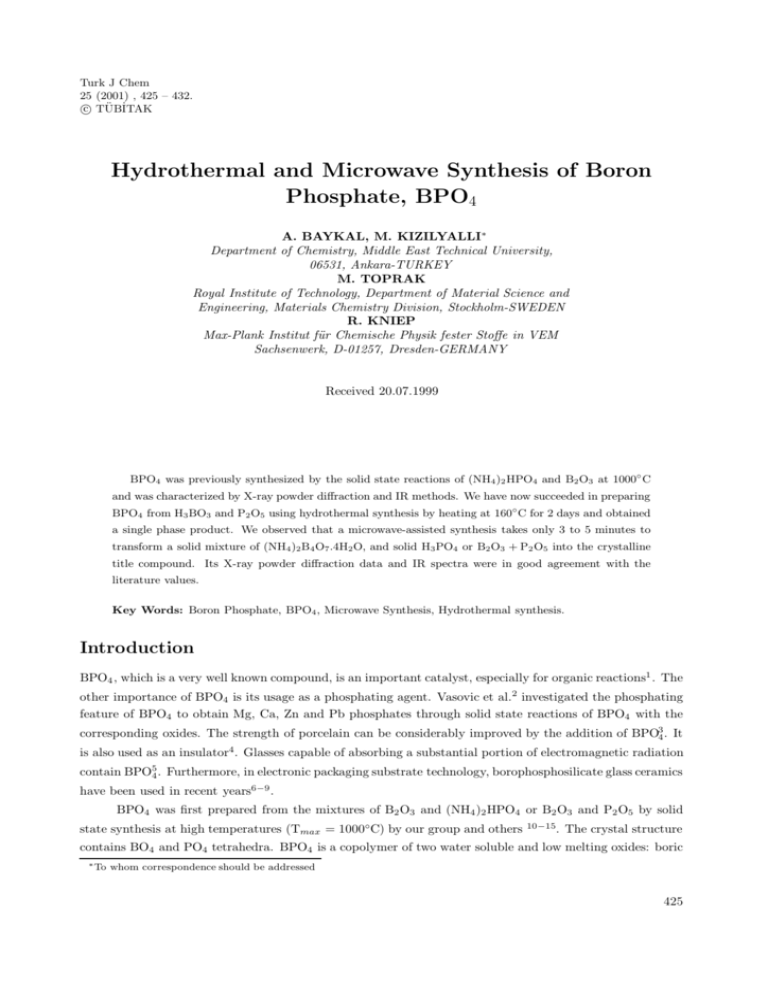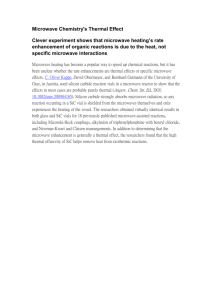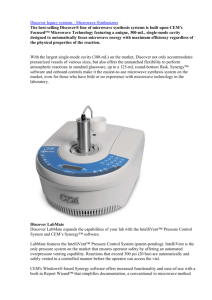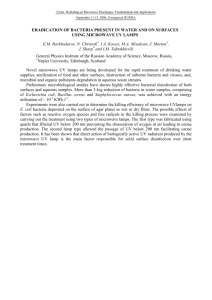Hydrothermal and Microwave Synthesis of Boron Phosphate, BPO4
advertisement

Turk J Chem 25 (2001) , 425 – 432. c TÜBİTAK Hydrothermal and Microwave Synthesis of Boron Phosphate, BPO4 A. BAYKAL, M. KIZILYALLI∗ Department of Chemistry, Middle East Technical University, 06531, Ankara-TURKEY M. TOPRAK Royal Institute of Technology, Department of Material Science and Engineering, Materials Chemistry Division, Stockholm-SWEDEN R. KNIEP Max-Plank Institut für Chemische Physik fester Stoffe in VEM Sachsenwerk, D-01257, Dresden-GERMANY Received 20.07.1999 BPO4 was previously synthesized by the solid state reactions of (NH4 )2 HPO4 and B2 O3 at 1000◦ C and was characterized by X-ray powder diffraction and IR methods. We have now succeeded in preparing BPO4 from H3 BO3 and P2 O5 using hydrothermal synthesis by heating at 160◦ C for 2 days and obtained a single phase product. We observed that a microwave-assisted synthesis takes only 3 to 5 minutes to transform a solid mixture of (NH4 )2 B4 O7 .4H2 O, and solid H3 PO4 or B2 O3 + P2 O5 into the crystalline title compound. Its X-ray powder diffraction data and IR spectra were in good agreement with the literature values. Key Words: Boron Phosphate, BPO4 , Microwave Synthesis, Hydrothermal synthesis. Introduction BPO4 , which is a very well known compound, is an important catalyst, especially for organic reactions1 . The other importance of BPO4 is its usage as a phosphating agent. Vasovic et al.2 investigated the phosphating feature of BPO4 to obtain Mg, Ca, Zn and Pb phosphates through solid state reactions of BPO4 with the corresponding oxides. The strength of porcelain can be considerably improved by the addition of BPO34 . It is also used as an insulator4 . Glasses capable of absorbing a substantial portion of electromagnetic radiation contain BPO54 . Furthermore, in electronic packaging substrate technology, borophosphosilicate glass ceramics have been used in recent years6−9 . BPO4 was first prepared from the mixtures of B2 O3 and (NH4 )2 HPO4 or B2 O3 and P2 O5 by solid state synthesis at high temperatures (Tmax = 1000◦C) by our group and others 10−15 . The crystal structure contains BO4 and PO4 tetrahedra. BPO4 is a copolymer of two water soluble and low melting oxides: boric ∗ To whom correspondence should be addressed 425 Hydrothermal and Microwave Synthesis of..., A. BAYKAL, et al., oxide and phosphorous oxide. It is insoluble, chemically inert and has a high softening point. It is a four connective crystalline polymer whose structure (Fig. 1) is similar to that of silica16. O O B O O P O P O B O B O O P P O O O O O O O O O O O O B O B O P O O O O P O O O B O O Figure 1. Structure of BPO4 In recent years, much progress has been made in the synthesis of materials by hydrothermal and microwave methods. Conventional techniques such as solid state reactions at high temperatures or photochemical, catalytic, ultrasonic and high pressure reactions are used to stimulate chemical reactions which proceed slowly under ambient conditions17 . On the other hand, the use of controlled microwave energy for ceramic processing and drying and for melting silica, alumina and aluminosilicate gels have been reported18 . Microwave heating techniques have stimulated interest in recent years because of their potential advantages, including significant reductions in manufacturing costs19 . Microwave energy is widely used to process a variety of ceramic materials. For example, the use of microwave plasma produces highly excited electronic states by the decomposition of gaseous species that recombine to give metastable phases. Kamo et al.20synthesized diamond depending on this principle. There are many advantages of microwave processing over conventional processing methods18,19,21: 1. Significant reductions in manufacturing costs due to energy savings and shorter processing times, 2. Improved product uniformity, 3. Improved or unique microstructure and properties. 4. Improved product quality, 5. Very rapid processing (2 to 50 times faster than conventional methods), 6. Capability of high energy concentration in short times and in selected regions, 7. Acceleration of sintering and diffusion and thus densification at lower temperatures. Microwave heating is fundamentally different from conventional processes. In the microwave process, heat is generated internally within the material instead of originating heat. The materials, that can be processed by microwave energy are dielectrics (electrically insulating) such as Al2 O3 , MgO and SiO2 and most glasses. They are transparent to microwaves at ambient temperatures19 . Recently, microwave energy was used for the synthesis of inorganic borophosphate materials such as Na5 [B2 P3 O13 ] prepared by our group. The synthesis of Na5 [B2 P3 O13 ] took only two minutes to transform a solid mixture of borate and phosphate hydrates into crystalline title compound22 . The basic idea for a microwave-assisted preparation of borophosphates is consistent with the observation of the high microwave susceptibilities of those phosphate and borate hydrates23 . A novel microwaveassisted preparation of crystalline and glassy materials using NaH2 PO4 .2H2 O, which has high absorbing microwave ability, was proposed by Vaidhyanathan and Rao23, in which microwave radiation is expected to activate the rotational degrees of freedom in H2 O molecules present in the sample NaH2 PO4 .2H2 O. The sample first melts as a consequence, forming a highly concentrated solution of NaH2 PO4 in H2 O. In the second stage, the H2 O molecules escape from the solution leaving behind “hot” NaH2 PO4 , which is suspected as it is itself sufficiently microwave absorbing either due to increased dielectric loss or due to the nearness of a dielectric anomaly. This material then continues to be heated even further where upon in the 426 Hydrothermal and Microwave Synthesis of..., A. BAYKAL, et al., third stage the chemically bound water (-H and –OH groups) in the structure of NaH2 PO4 is eliminated by condensation. Anhydrous NaPO3 melt is formed at the end. Vaidhyanathan et al. also tested some phosphate and borate compounds for their microwave-absorbing abilities23,24. According to this study, with Na2 B4 O7 .10H2 O, when exposed to microwave radiation for 7 minutes, weight loss was observed. It was found to be dehydrated and a porous product was obtained. For Na3 BO3 .4H2 O (7-minute exposure), the same results were observed except the product had a rubbery appearance. Recent reports of the syntheses of several inorganic solids have been reviewed by Rao et al.24. In this work, we developed a previously unreported simple and fast microwave-assisted reaction for the synthesis of BPO4 . On the other hand, to synthesize single crystal and polycrystalline compounds, hydrothermal synthesis is an excellent method. A lot of chromate, phosphate, borate, and borophosphate compounds are produced with hydrothermal synthesis25 . The most common arrangement required for such crystallization is the temperature gradient that helps to transport the material from the zone of high solubility to the zone of low solubility. This method has some significant advantages over other chemical synthesis techniques. Many materials can be produced directly in the desired crystalline phase at relatively low temperatures (around 350◦ C), thus eliminating any need for the calcination treatment prior to sintering. Most of the borophosphates are preferably prepared by hydrothermal methods at temperatures below 200◦C, like Na5 [B2 P3 O13 ]22, (NH4 )2 [B3 PO7 (OH)2 ]2 , Li[B3 PO6 (OH)3 ]27 , K3 [B5 PO10 (OH)3 ]28 , NH4 Mg(H2 O)2 [BP2 O8 ].H2 O[29,30], NaMg(H2 O)2 [BP2 O8 ].H2 O30,31 and Fe (H2 O)2 [BP2 O8 ].H2 O32 . The preparation of BPO4 by a hydrothermal method was also presented for the first time in this paper. In addition to the two above methods, the sol-gel method was also proved to be good method for synthesis of BPO33 4 . Starting from the ethanol-derived precursor, Af et al. synthesized BPO4 directly by a sol-gel route34 . Experimental Substances (NH4 )2 B4 O7 . 4H2 O, H3 PO4 , H3 BO3 , B2 O3 , (NH4 )2 HPO4 and P2 O5 (from Merck and Aldridge) Instruments X-ray powder diffraction patterns (XRD) were taken by using a Philips diffractometer with PW 1050/25 goniometer and Co Kα radiation (30-40 kV, 10-20 mA, λ = 1.79021 Å) and Huber Diffractometer with Cu Kα radiation (30-40 kV, 10-20 mA, λ = 1.54059 Å). A Nicolet 510 FTIR Infrared Spectrometer was used in the region 400-4000 cm−1 . Spectra of solid samples were obtained from KBr pellets with a 100:10 (wt/wt) KBr to product ratio. The solid state reactions were carried out in air with the aid of Heraous, SFL West-6100, and Ney 2-525 furnaces. The heating range was 550-1500◦C using Cr-Ni-Cr and Rh-Pt-Rh thermocouples and controller. Microwave reactions were carried out in an Arçelik MD58 I, kitchen-type microwave oven (2.450GHz, 1000 W). 427 Hydrothermal and Microwave Synthesis of..., A. BAYKAL, et al., Procedure Three different (two new and one conventional) routes were employed for the synthesis of BPO4 . For microwave-assisted synthesis of BPO4 , a dry and ground solid mixture (2.5g) of (NH4 )2 B4 O7 .4H2 O and H3 PO4 (molar ratio of 1:4) was placed in a Teflon beaker and was treated in a conventional kitchen microwave system (2.450 GHz; max 1000 W) for a short period (3 minutes). The mixture melted partially after exposure to microwave radiation and copious bubbling of the materials was seen. After 3 minutes, the irradiation was terminated and the sample was allowed to cool inside the oven. The proposed reaction for the microwave-assisted synthesis of BPO4 is as follows: (NH4 )2 B4 O7 . 4H2 O(s) + 4H3 PO4 (s) −→ 4BPO4 (s) + 2NH3 (g) + 11H2 O(g) This experiment was also performed for the mixture of B2 O3 and P2 O5 , according to the chemical reaction given below. The time required for this reaction is about 5 minutes. The following reaction is expected: B2 O3 (s) + P2 O5 (s) −→ 2BPO4 (s) On the other hand, the synthesis of BPO4 was carried out by a hydrothermal method starting from mixtures H3 BO3 and P2 O5 in a 6:1 molar ratio. The reactants were mixed in 10 ml distilled water and treated under stirring with 25 ml concentrated HNO3 until the components dissolved completely. The clear solution was heated without boiling and concentrated to 15 ml and then transferred to a Teflon-coated steel autoclave (65% filling) and heated at 160◦C for 2 days. The crystalline products were filtered off in vacuo, washed with distilled water and dried at 60◦ C. For the solid state synthesis of BPO4 , for comparison purposes, the reaction was performed at 1000◦C in a porcelain crucible. In order to prevent melting of the reactants, the heating rate was kept slow during the first heating. For this purpose, the mixture was heated to 300◦C at a rate of 2◦ C/min. Then the temperature was gradually increased to 1000◦C and the sample was kept at this temperature for 7 h. The proposed chemical reaction is as follows: B2 O3 (s) + 2(NH4 )2 HPO4 (s) −→ 2BPO4 (s) + 4NH3 (g) + 3H2 O(g) Results and Discussion The first step of the microwave-assisted reaction (∼1 minute) is the loss of water molecules from the components. Then flashes are seen in the center of the mixture. The reaction mixture continues to glow during the duration of the reaction (Fig. 2) as stated by Vaidhyanathan and Rao21 for other reactions. Due to this glowing, the temperature of the solid mixture increases suddenly. However, it is not obvious which materials (starting materials or products) caused an increase in temperature. We were able to take a photograph of the reaction vessel only when the door of the microwave oven was closed. Unfortunately it was impossible to measure the temperature during glowing. However, to estimate approximately the lower bound of the reaction temperatures, control experiments were performed in open atmosphere for nitrides. It was found that the approximate temperature after 5 minutes exposure in air was around 870-1100 K21 . 428 Hydrothermal and Microwave Synthesis of..., A. BAYKAL, et al., Figure 2. Photograph Taken During the Reaction of (NH4 )2 B4 O7 .2H2O + H3 PO4 by Microwave Method (i) Rel. Intensity (ii) 30 40 2 Theta — — 20 — — 10 — — (iii) 50 60 70 Figure 3. The X-ray Powder Diffraction Pattern of the Products Obtained by i) Solid State Reaction, ii) Hydrothermal Reaction and iii) Microwave-Assisted Method 429 Hydrothermal and Microwave Synthesis of..., A. BAYKAL, et al., The X-ray powder patterns of the products obtained by solid state (i), hydrothermal (ii) and microwave methods (iii) using (NH4 )2 B4 O7 .4H2 O + 4H3 PO4 were the same but their intensities were different (Fig. 3). All the peaks in the X-ray powder pattern belong to tetragonal BPO4 . The X-ray powder pattern of 15 — 10 — — 5 — Intensity the product obtained by the reaction of B2 O3 and P2 O5 with microwave method is presented in Fig. 4.The extra weak peaks in the patterns are due to vaseline, which was used in the sample preparation. 20 25 30 2 Theta Figure 4. The X-Ray Powder Diffraction Pattern of the Product for B2 O3 + P2 O5 Reactions Using Microwave Method The crystal structure of BPO4 obtained in all reactions is tetragonal. The reported unit cell parameters (JCPDS card No: 34-132) are a = 4.342, c = 6.645 Å, which are in good agreement with our unit cell parameters and the ones reported with others10,11,35. There was a good agreement between the IR spectrum of BPO4 and tetragonal BPO4 given in the literature16,36 . The IR spectrum of boron phosphate contains four strong, rather broad bands at 550, 615, 925, and 1085 cm−1 , which can be seen in Fig. 5. As stated by Kniep et al.37, P-O-P linking was not present — 2500 2000 1500 Wavenumber (cm-1) — — 3000 — 3500 — — 4000 — % Transmittance in borophosphates, which was confirmed in this study38 . 1000 500 Figure 5. IR Spectrum of BPO4 Conclusion Phosphates have traditionally been synthesized by means of a solid state reactions at high temperatures. In this study, boron phosphate, BPO4 , was successfully synthesized through solid state, hydrothermal 430 Hydrothermal and Microwave Synthesis of..., A. BAYKAL, et al., and microwave-assisted reactions. Microwave-assisted methods have many benefits over the conventional methods, such as shorter reaction time, lower energy requirements and pure phase composition. The IR and powder diffraction pattern is in good agreement with the reported data. Acknowledgments Financial support for this research was provided by the Scientific and Technical Research Council of Turkey (TÜBİTAK), and METU AFP project No: 98-06-02-00-06. References 1. G.J. Hutchings, I.D. Hudson and D.G. Timms, Journal of the Chemical Society Chemical Communications, 23, 2717-2718, 1994. 2. D.D. Vasovic, D.R. Stojakovic and S.P. Zec, Mat.Res.Bull., 32(6), 779-784, 1997. 3. K.H. Schueller, Ber.Deu.Keram.Ges., 44(6), 284-293, 1967. 4. E.J. Croop and C.H.Vondracek, Westinghouse Electric Corp. Pat:Fr., 1, 338-381, (cl, c01b H01b) Feb 5, 1965. 5. R. Parry and A.M. Reid, Pat:Fr.1, 359, 103 (cl.c08c), April 24. 6. P.N. Kumta, M.A. Sriram, J. of Material Science, 28, 1097-1106,1993. 7. R. Hsu, and P.N. Kumta, J.of Material Science, 30, 3123-3129, 1995. 8. R. Hsu, J.Y. Kim, P.N. Kumta, and T.P. Feist, Chemistry of Materials, 8, 107-113, 1996. 9. A. Baykal, and M. Kızılyallı, J. of Chemical Eng., Turkey, 152, 1997. 10. Nat. Bur. Stand. (U.S.) Monogr., 25(20), 23, 1983. 11. F. Dachille, and L. Dent-Glasser, Acta Crystallogr., 12, 280-81, 1959. 12. H. Goltz and J.B. Moffat., Journal of Catal., 22, 85, 1971. 13. H.L. Baccaredda, G.F. Neucetti, and R. Tartarelli, Chim.Ind.Milan., 45, 1483, 1963. 14. A. Yılmaz, Master Thesis, Chemistry Dept. of METU, Ankara,1995 15. M. Toprak, Master Thesis, Chemistry Dept. of METU, Ankara, 1996 16. N.H. Ray, Inorganic Polymers, London, Academic Press, 1978. 17. D.M.P. Mingos and D.R. Baghurst, Chem. Soc. Rev., 20, 1, 1991. 18. R. Roy, S. Komarneni and L.J.Yang, J. Am. Cer. Soc., 68(7), 392-395, 1985. 19. W.H. Sutton, Ceramic Bulletin, 68(2), 376-386, 1989. 20. M. Kamo, Y. Sato, S. Matsumato, and N. Setaka, J. Cryst. Growth, 62(3), 642, 1983. 21. B. Vaidhyanathan and K.J. Rao, Chem. Mater., 9, 1196-1200, 1997. 22. C. Hauf, A. Yılmaz, M. Kızılyallı and R. Kniep, J. Solid State Chem., 140, 154-156, 1998. 23. B. Vaidhyanathan and K.J. Rao, J.Solid State Chemistry, 132, 349-354, 1997. 24. K.J. Rao, B. Vaidhyanathan, M. Ganguli and P.A. Ramakrishnan, Chem. Mat., 11, 882-895, 1999. 431 Hydrothermal and Microwave Synthesis of..., A. BAYKAL, et al., 25. K. Byrappa, Progress in Crystal Growth and Characterization of Materials, vol.21, Frankfurt, Pergamon Press, 1991. 26. C. Hauf, and R. Kniep, Zeitschrift für Kristallographie, 211, 705-706, 1996. 27. C. Hauf, and R. Kniep, Zeitschrift für Kristallographie, 212, 313-314, 1997. 28. C. Hauf, and R. Kniep, Zeitschrift für Kristallographie, 211, 707-708, 1996. 29. A. Baykal, Ph.D Thesis, Chemistry Dept. of METU, Ankara, 1999. 30. A. Baykal., M. Kızılyallı, and R. Kniep , J. Mat. Science, 35, 4621-4626, 2000 31. R. Kniep, G. Will, I. Boy, and C. Röhr, Angew. Chem. Int. Ed. Engl., 36(9), 1013-1018, 1997. 32. A. Yılmaz, X. Bu, M. Kızılyallı and G.D. Stucky, Chem. Mater. 12, 3243-3245, 2000. 33. A. Marotta, P. Pernice, F. Branda, A. Aronne, and A. Buri, Journal of Non-Crystalline Solids, 95-6, 593-600, 1987. 34. A. Af, P. Mustarelli, and A. Magistris, Mat. Res. Bull., 33(5), 697-710.1998. 35. J.R.Wazer Van, Phosphorous and Its Compounds., New York, Interscience Publishers, 1958. 36. R.A. Nyquist and R.O. Kagel, Infrared Spectra of Inorganic Compounds, New York, Academic Press, 1971. 37. R. Kniep, H. Engelhardt and C. Hauf, Chem. Mat. 10(10), 2930-2934, 1998. 38. A. Baykal, M.Kızılyallı, M. Toprak, and R. Kniep, Collequim Spectropicum Internationale XXXI, Sept 5-10 1999, Ankara, Turkey 432





